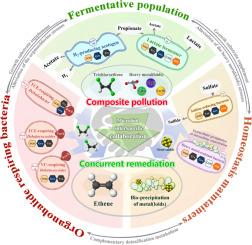当前位置:
X-MOL 学术
›
Water Res.
›
论文详情
Our official English website, www.x-mol.net, welcomes your
feedback! (Note: you will need to create a separate account there.)
Sulfate-driven microbial collaboration for synergistic remediation of chloroethene-heavy metal pollution
Water Research ( IF 11.4 ) Pub Date : 2024-11-02 , DOI: 10.1016/j.watres.2024.122738 Zheng-Tao Li, He-Ping Zhao
Water Research ( IF 11.4 ) Pub Date : 2024-11-02 , DOI: 10.1016/j.watres.2024.122738 Zheng-Tao Li, He-Ping Zhao

|
The treatment of heavy metal(loid) (HM) composite pollution has long posed a challenge for the bioremediation of organohalide-contaminated sites. Given the prevalent cohabitation of sulfate-reducing bacteria (SRB) with organohalide-respiring bacteria (OHRB), we proposed a sulfate-amendment strategy to achieve synergistic remediation of trichloroethene and diverse HMs [50μM of As(III), Ni(II), Cu(II), Pb(II)]. Correspondingly, 50–75 μM sulfate was introduced to HM inhibitory batches to investigate the enhancement effect of sulfate amendment on bio-dechlorination. Dechlorination kinetics and MATLAB modeling indicated that sulfate amendment comprehensively improved the reductive dechlorination performance in the presence of As(III), Ni(II), Pb(II) and mixed HMs, while no enhancement was observed under Cu(II) exposure. Additionally, sulfate introduction effectively accelerated the detoxification of Ni(II), Pb(II), Cu(II), and As(III), achieving removal efficiencies of 76.87 %, 64.01 %, 86.37 %, and 95.50 % within the first three days, respectively. Meanwhile, propionate dynamics and acetogenesis indicated enhanced carbon source and e-donor supply. 16S rRNA gene sequencing and metagenomic analysis results demonstrated that HM sequestration was accomplished jointly by SRB and HM-resistant bacteria via extracellular precipitation (metal sulfide) and intracellular sequestration, while their contribution depended on the specific coexisting HM species present. This study highlights the critical role of sulfate in the concurrent bioremediation of HM-organohalide composite contamination and provides insights for developing a cost-effective in-situ bioremediation strategy.
中文翻译:

硫酸盐驱动的微生物合作协同修复氯乙烯-重金属污染
长期以来,重金属 (HM) 复合污染的处理一直是有机卤化物污染场地的生物修复挑战。鉴于硫酸盐还原菌 (SRB) 与有机卤化物呼吸细菌 (OHRB) 的普遍共存,我们提出了一种硫酸盐修正策略,以实现三氯乙烯和各种 HMs [50μM As(III)、Ni(II)、Cu(II)、Pb(II)] 的协同修复。相应地,将 50–75 μM 硫酸盐引入 HM 抑制批次中,以研究硫酸盐改良剂对生物脱氯的增强作用。脱氯动力学和 MATLAB 模型表明,硫酸盐改性在 As(III)、Ni(II)、Pb(II) 和混合 HMs 存在下全面提高了还原脱氯性能,而在 Cu(II) 暴露下未观察到增强。此外,硫酸盐的引入有效地加速了 Ni(II)、Pb(II)、Cu(II) 和 As(III) 的解毒,在前 3 天内分别实现了 76.87 % 、 64.01 % 、 86.37 % 和 95.50 % 的去除效率。同时,丙酸盐动力学和乙酸生成表明碳源和电子供体供应增加。16S rRNA 基因测序和宏基因组分析结果表明,HM 隔离由 SRB 和 HM 耐药细菌通过细胞外沉淀(金属硫化物)和细胞内隔离共同完成,而它们的贡献取决于存在的特定共存 HM 物种。本研究强调了硫酸盐在 HM-有机卤化物复合污染的同步生物修复中的关键作用,并为开发具有成本效益的原位生物修复策略提供了见解。
更新日期:2024-11-05
中文翻译:

硫酸盐驱动的微生物合作协同修复氯乙烯-重金属污染
长期以来,重金属 (HM) 复合污染的处理一直是有机卤化物污染场地的生物修复挑战。鉴于硫酸盐还原菌 (SRB) 与有机卤化物呼吸细菌 (OHRB) 的普遍共存,我们提出了一种硫酸盐修正策略,以实现三氯乙烯和各种 HMs [50μM As(III)、Ni(II)、Cu(II)、Pb(II)] 的协同修复。相应地,将 50–75 μM 硫酸盐引入 HM 抑制批次中,以研究硫酸盐改良剂对生物脱氯的增强作用。脱氯动力学和 MATLAB 模型表明,硫酸盐改性在 As(III)、Ni(II)、Pb(II) 和混合 HMs 存在下全面提高了还原脱氯性能,而在 Cu(II) 暴露下未观察到增强。此外,硫酸盐的引入有效地加速了 Ni(II)、Pb(II)、Cu(II) 和 As(III) 的解毒,在前 3 天内分别实现了 76.87 % 、 64.01 % 、 86.37 % 和 95.50 % 的去除效率。同时,丙酸盐动力学和乙酸生成表明碳源和电子供体供应增加。16S rRNA 基因测序和宏基因组分析结果表明,HM 隔离由 SRB 和 HM 耐药细菌通过细胞外沉淀(金属硫化物)和细胞内隔离共同完成,而它们的贡献取决于存在的特定共存 HM 物种。本研究强调了硫酸盐在 HM-有机卤化物复合污染的同步生物修复中的关键作用,并为开发具有成本效益的原位生物修复策略提供了见解。


















































 京公网安备 11010802027423号
京公网安备 11010802027423号